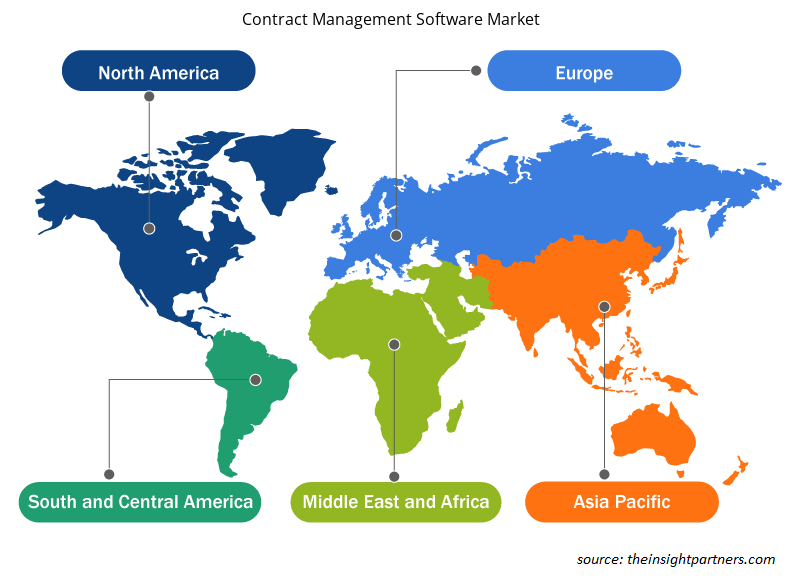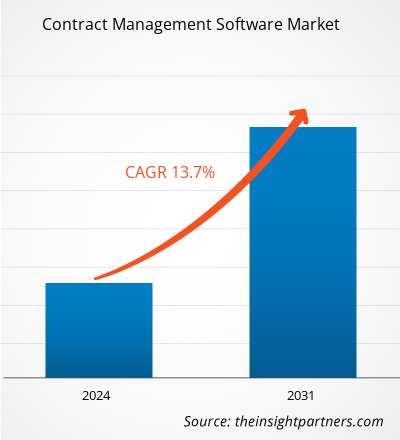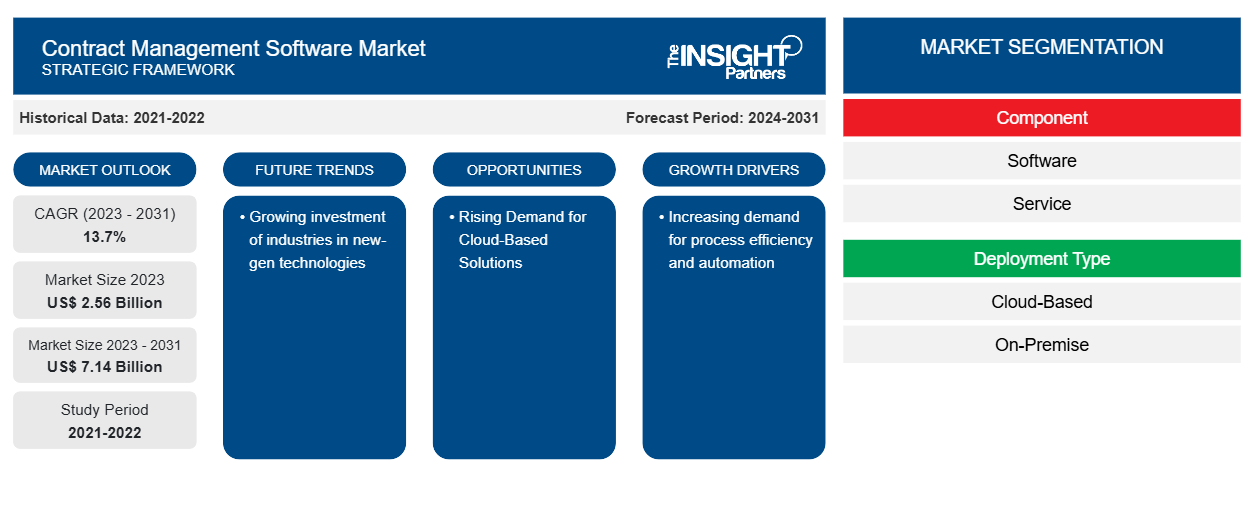Si prevede che la dimensione del mercato del software di gestione dei contratti raggiungerà i 7,14 miliardi di dollari entro il 2031, rispetto ai 2,56 miliardi di dollari del 2023. Si prevede che il mercato registrerà un CAGR del 13,7% nel 2023-2031. È probabile che il crescente investimento delle industrie in tecnologie di nuova generazione rimanga una tendenza chiave del mercato del software di gestione dei contratti.
Analisi di mercato del software di gestione dei contratti
Le soluzioni di gestione dei contratti aiutano i consulenti legali a raccogliere contratti comparabili dalla biblioteca per riferimento, che possono essere visualizzati virtualmente in formati quali PowerPoint, Microsoft Word ed Excel. Ciò riduce i tempi di revisione e consente alle aziende di individuare difetti nel loro sistema, il che sta alimentando la crescita del mercato a livello globale. Consente inoltre alle aziende di garantire la conformità alle normative emanate dagli enti di regolamentazione. Inoltre, migliora l'efficienza operativa e la trasparenza nei sistemi di reporting e nei controlli di gestione. Inoltre, come risultato della crescente globalizzazione, un approccio collaborativo alla gestione dei progetti e alle joint venture sta diventando sempre più importante poiché fornisce visibilità del contratto a tutte le parti coinvolte, il che sta aumentando l'adozione di soluzioni di gestione dei contratti. Inoltre, si prevede che la crescente domanda di software di gestione dei contratti basato su cloud creerà un'opportunità per la crescita del mercato nel periodo previsto .
Panoramica del mercato del software di gestione dei contratti
Il software di gestione dei contratti assiste avvocati e altri professionisti nella creazione, negoziazione, rinnovo e raccolta dati degli attuali contratti aziendali. Il software di gestione dei contratti è uno strumento essenziale per garantire che l'intento di ogni contratto nell'organizzazione sia pienamente realizzato. Inoltre, il software può aiutare a migliorare le prestazioni contrattuali assicurando l'applicazione dei termini commerciali, accelerando il flusso di cassa e il time-to-revenue e riducendo il rischio di non conformità.
Personalizza questo report in base alle tue esigenze
Riceverai la personalizzazione gratuita di qualsiasi report, comprese parti di questo report, o analisi a livello nazionale, pacchetto dati Excel, oltre a usufruire di grandi offerte e sconti per start-up e università
-
Scopri le principali tendenze di mercato in questo rapporto.Questo campione GRATUITO includerà analisi di dati che spaziano dalle tendenze di mercato alle stime e alle previsioni.
Driver e opportunità di mercato per il software di gestione dei contratti
Crescente domanda di efficienza dei processi e automazione
Poiché le aziende mirano a ridurre gli errori umani e le inefficienze nella gestione del ciclo di vita dei contratti, migliorando al contempo l'efficienza operativa, la domanda di software di gestione dei contratti sta aumentando sul mercato. Il software di gestione dei contratti semplifica l'amministrazione dei contratti automatizzando attività ripetitive come la preparazione dei contratti, i flussi di lavoro di approvazione, l'archiviazione dei documenti e gli avvisi di rinnovo. L'automazione determina un aumento della domanda di sistemi di gestione dei contratti poiché riduce l'onere amministrativo, accorcia i tempi del ciclo dei contratti e aumenta la produttività. Pertanto, la crescente domanda di efficienza dei processi e automazione sta aumentando il mercato del software di gestione dei contratti.lifecycle management while also enhancing operational efficiency, the demand for contract management software is increasing in the market. Contract management software streamlines the administration of contracts by automating repetitive tasks such as contract preparation, approval workflows, document
Crescente domanda di soluzioni basate su cloud
Il software di gestione dei contratti basato su cloud ha un'interfaccia facile da usare, consente approvazioni dinamiche dei processi, si integra perfettamente con i sistemi di gestione dei contratti più diffusi e riduce notevolmente le spese totali. Inoltre, il software di gestione dei contratti basato su cloud consente alle organizzazioni di accedere ai dati e agli strumenti dei contratti da qualsiasi luogo e in qualsiasi momento utilizzando qualsiasi dispositivo connesso a Internet. Quindi, poiché il software aiuta a soddisfare le aspettative delle aziende in crescita e consente un'integrazione perfetta con altri sistemi aziendali , la sua domanda sta aumentando in tutto il mondo. Pertanto, si prevede che il crescente investimento nell'infrastruttura della smart grid creerà un'opportunità per la crescita del mercato del software di gestione dei contratti.
Analisi della segmentazione del rapporto di mercato del software di gestione dei contratti
I segmenti chiave che hanno contribuito alla derivazione dell'analisi di mercato del software di gestione dei contratti sono componente, tipo di distribuzione, funzione aziendale e verticale.
- In base all'offerta, il mercato del software di gestione dei contratti è diviso in software e servizi. Il segmento software ha detenuto una quota di mercato maggiore nel 2023.
- In base al tipo di distribuzione, il mercato è segmentato in cloud-based e on-premise. Si prevede che il segmento cloud-based crescerà nel periodo previsto.
- In base alla funzione aziendale, il mercato è segmentato in legale, vendite, approvvigionamento e altri. Si prevede che il segmento legale crescerà nel periodo previsto.
- Per verticale, il mercato è segmentato in sanità e scienze della vita, trasporti e logistica, governo, produzione, telecomunicazioni e IT, BFSI, altri. Si prevede che il segmento sanità e scienze della vita crescerà nel periodo previsto.
Analisi della quota di mercato del software di gestione dei contratti per area geografica
L'ambito geografico del rapporto di mercato sul software di gestione dei contratti è principalmente suddiviso in cinque regioni:Nord America, Asia Pacifico, Europa, Medio Oriente e Africa e Sud America/Sud e Centro America.
Si prevede che il Nord America assisterà a una crescita significativa nel mercato del software di gestione dei contratti. Il mercato in questa regione è segmentato in Stati Uniti, Canada e Messico. Le organizzazioni hanno aumentato l'apertura nella gestione dei contratti implementando policy e l'utilizzo di sistemi di gestione dei contratti semplificati è uno dei principali fattori che alimentano la crescita del mercato nella regione. Inoltre, leggi come l'Health Insurance Portability & Accountability Act (HIPAA) incoraggiano l'uso di programmi di gestione dei contratti, stimolando ulteriormente la crescita del mercato. Inoltre, la regione è composta da un gran numero di attori del mercato che lavorano costantemente all'avanzamento del software, il che alimenta ulteriormente la crescita del mercato nella regione.
Approfondimenti regionali sul mercato del software di gestione dei contratti
Le tendenze regionali e i fattori che influenzano il mercato del software di gestione dei contratti durante il periodo di previsione sono stati ampiamente spiegati dagli analisti di Insight Partners. Questa sezione discute anche i segmenti e la geografia del mercato del software di gestione dei contratti in Nord America, Europa, Asia Pacifico, Medio Oriente e Africa e America meridionale e centrale.

- Ottieni i dati specifici regionali per il mercato del software di gestione dei contratti
Ambito del rapporto di mercato sul software di gestione dei contratti
| Attributo del report | Dettagli |
|---|---|
| Dimensioni del mercato nel 2023 | 2,56 miliardi di dollari USA |
| Dimensioni del mercato entro il 2031 | 7,14 miliardi di dollari USA |
| CAGR globale (2023-2031) | 13,7% |
| Dati storici | 2021-2022 |
| Periodo di previsione | 2024-2031 |
| Segmenti coperti |
Per componente
|
| Regioni e Paesi coperti |
America del Nord
|
| Leader di mercato e profili aziendali chiave |
|
Densità dei player del mercato del software di gestione dei contratti: comprendere il suo impatto sulle dinamiche aziendali
Il mercato del software di gestione dei contratti sta crescendo rapidamente, spinto dalla crescente domanda degli utenti finali dovuta a fattori quali l'evoluzione delle preferenze dei consumatori, i progressi tecnologici e una maggiore consapevolezza dei vantaggi del prodotto. Con l'aumento della domanda, le aziende stanno ampliando le loro offerte, innovando per soddisfare le esigenze dei consumatori e capitalizzando sulle tendenze emergenti, il che alimenta ulteriormente la crescita del mercato.
La densità degli operatori di mercato si riferisce alla distribuzione di aziende o società che operano in un particolare mercato o settore. Indica quanti concorrenti (operatori di mercato) sono presenti in un dato spazio di mercato in relazione alle sue dimensioni o al valore di mercato totale.
Le principali aziende che operano nel mercato del software di gestione dei contratti sono:
- Agiloft Inc
- Società Apttus
- Società di consulenza Wolters Kluwer
- Software CobbleStone
- ContrattiSaggi
- Società IBM
Disclaimer : le aziende elencate sopra non sono classificate secondo un ordine particolare.

- Ottieni una panoramica dei principali attori del mercato dei software di gestione dei contratti
Notizie di mercato e sviluppi recenti del software di gestione dei contratti
Il mercato del software di gestione dei contratti viene valutato raccogliendo dati qualitativi e quantitativi dopo la ricerca primaria e secondaria, che include importanti pubblicazioni aziendali, dati associativi e database. Di seguito è riportato un elenco degli sviluppi nel mercato dei disturbi e delle strategie del linguaggio e della parola:
- Agiloft, lo standard globale nella gestione agile del ciclo di vita dei contratti (CLM), ha annunciato che Kroll è entrata a far parte della rete globale di partner di servizi di Agiloft. Kroll offre un'ampia gamma di servizi per aiutare i clienti a implementare, mantenere e guidare l'adozione della piattaforma CLM basata sull'intelligenza artificiale di Agiloft. Combinando le migliori pratiche di gestione dei contratti e dei processi legali, tecnologia comprovata e rigoroso supporto all'implementazione dei sistemi, i suoi team trasformano la contrattualizzazione da un collo di bottiglia a un abilitatore aziendale per le aziende in settori verticali chiave, tra cui servizi finanziari, scienze biologiche, energia, alta tecnologia e altri. (Fonte: Agiloft, comunicato stampa, 2023)
- Icertis ha annunciato il lancio di Icertis Contract Intelligence (ICI) per servizi bancari e finanziari. La nuova soluzione di gestione del ciclo di vita dei contratti (CLM) è dotata di funzionalità pronte all'uso che includono una gamma di tipi di contratto, regole per identificare gli obblighi e flusso di lavoro e reporting per supportare sfide specifiche nei processi aziendali negli uffici front, middle e corporate delle organizzazioni di servizi bancari e finanziari. La soluzione aiuterà i team ad aumentare la velocità aziendale gestendo al contempo il rischio e migliorando la conformità normativa alle aree di obbligo come AML, supporto al credito ISDA e revisioni del rischio di credito. (Fonte: Icertis, comunicato stampa, 2022)
Copertura e risultati del rapporto di mercato sul software di gestione dei contratti
Il rapporto "Dimensioni e previsioni del mercato del software di gestione dei contratti (2021-2031)" fornisce un'analisi dettagliata del mercato che copre le seguenti aree:
- Dimensioni e previsioni del mercato a livello globale, regionale e nazionale per tutti i segmenti di mercato chiave coperti dall'ambito
- Dinamiche di mercato come fattori trainanti, vincoli e opportunità chiave
- Principali tendenze future
- Analisi dettagliata delle cinque forze PEST/Porter e SWOT
- Analisi di mercato globale e regionale che copre le principali tendenze di mercato, i principali attori, le normative e gli sviluppi recenti del mercato
- Analisi del panorama industriale e della concorrenza che copre la concentrazione del mercato, l'analisi della mappa di calore, i principali attori e gli sviluppi recenti
- Profili aziendali dettagliati
- Analisi storica (2 anni), anno base, previsione (7 anni) con CAGR
- Analisi PEST e SWOT
- Valore/volume delle dimensioni del mercato - Globale, Regionale, Nazionale
- Industria e panorama competitivo
- Set di dati Excel
Report recenti
Rapporti correlati
Testimonianze
Motivo dell'acquisto
- Processo decisionale informato
- Comprensione delle dinamiche di mercato
- Analisi competitiva
- Analisi dei clienti
- Previsioni di mercato
- Mitigazione del rischio
- Pianificazione strategica
- Giustificazione degli investimenti
- Identificazione dei mercati emergenti
- Miglioramento delle strategie di marketing
- Aumento dell'efficienza operativa
- Allineamento alle tendenze normative























 Ottieni un campione gratuito per - Mercato del software di gestione dei contratti
Ottieni un campione gratuito per - Mercato del software di gestione dei contratti